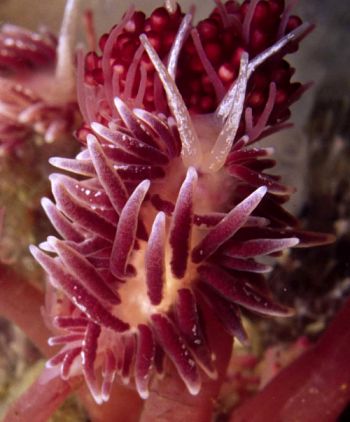
Cuthona punicea
Millen, 1986
Order: NUDIBRANCHIA
Suborder: AEOLIDINA
Family: Tergipedidae
DISTRIBUTION
Known only from British Columbia, Canada
PHOTO
Plumper Rock, near Telegraph Cove, Vancouver Island, British Columbia, Canada. August, 2001
Depth: 21 meters, Length: 12mm. Photo: Marli Wakeling
"The body is relatively stout, wider in front than behind and up to 24 mm in length. the body colour is transluscent white or pale peach, with peach ovotestis, reddish tipped jaws and small black eyes visible through the skin. The oral tentacles are long, up to 5 mm, slightly flattened and wider at their bases. The dorsal surface of each oral tentacle is encrusted with opaque white spots forming a broad line. The tentacles arise from the anterolateral corners of the head. The rhinophores are up to 8 mm long and are smooth, cylindrical, widest at their bases. All surfaces of the rhinophores are flecked with opaque white pigment spots. These spots are densest posteriorly and towards the tips, sometimes coalescing to form a line. The head is oval, not wider than the foot, with a T-shaped mouth. The cerata are elongate, cylindrical, and up to 7 mm long. They are slightly flattened proximally, have blunt, rounded tips, and contain small cnidosacs. The digestive diverticula vary in colour from dark wine-red to purple. In animals that have recently fed, the diverticula fill the cerata and give them a bumpy outline. In starved animals the diverticula appear to have short irregular knobs. The ceratal sheaths are transparent grey towards the dorsum, shading to white in the distal one-third, where there are numerous subepidermal glands. The cerata appear white tipped beyond the extension of the digestive diverticula because the glands are densest in this area. The extreme tips, however, lack subepidermal glands. In some animals the outermost third of the ceratal sheath takes on a peach-coloured hue. The cerata have a broken line of opaque white pigment, sometimes appearing as a line of spots down their outer sides. The cerata are arranged in 13-23 irregular, transverse rows. The rows are not simple but are usually paired, forming a horseshoe with the largest, innermost cerata in the center. The tall, fluted anal papilla is posterior in the interhepatic space and immediately anterior to the dorsalmost ceras in the first postcardiac row, although the anterior branch of the second postcardiac row is dorsal to it. The renal pore is slightly antedorsal to the anus. The gonopore is below the 2nd-4th rows of the right anterior hepatic branch. The foot is rounded anteriorly and triangular in shape, tapering posteriorly to a wide, bluntly rounded tail. There is a moderately large foot flange". [From Millen, 1986]
Compare with Cuthona columbiana. [= Catriona columbiana]
Reference:
• Millen, S.V. (1986) Northern, primitive Tergipedid nudibranchs, with a description of a new species from the Canadian Pacific. Canadian Journal of Zoology, 64(6): 1356-1362.
Rudman, W.B., 2003 (October 19) Cuthona punicea Millen, 1986. [In] Sea Slug Forum. Australian Museum, Sydney. Available from http://www.seaslugforum.net/factsheet/cuthpuni
Related messages
-
Cuthona punicea on food hydroid
From: Marli Wakeling, July 9, 2007 -
Cuthona punicea egg masses
From: Jackie Hildering & Glen Miller, March 24, 2007 -
Cuthona punicea from British Columbia
From: Paul Sim, October 21, 2003 -
Cuthona punicea from Canada
From: Wendy Atkinson, July 25, 2002 -
Re: Cuthona punicea from British Columbia
From: Dave Behrens, June 1, 2002 -
Cuthona punicea from British Columbia
From: Marli Wakeling, May 31, 2002 -
Cuthona punicea from British Columbia
From: Marli Wakeling, October 25, 2001
